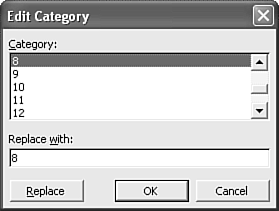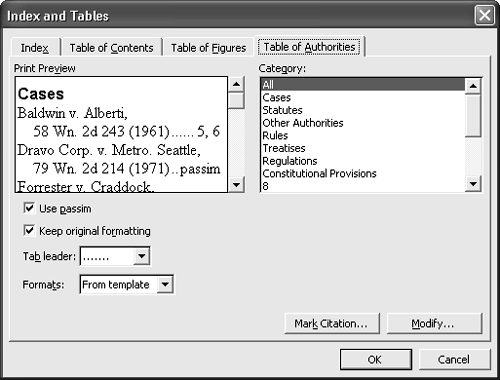Introducing Citations
If you're responsible for preparing legal documents, you know that special techniques are required to insert and track citations, which are references to cases, statutes, or other legal documents. Word streamlines both the process of marking citations and the process of collecting them into tables of authorities.
TIP
If you prepare legal documents, you may be interested in the Legal Pleading Wizard, which streamlines the process of creating reusable document templates that follow the requirements of the courts you work with.
To work with the Legal Pleading Wizard, choose File, New; click On My Computer on the New Document Task Pane; click the Legal Pleadings tab; and double-click the Pleading Wizard icon.
Marking Citations
There's nothing unusual about entering the text of your citations: You simply type them as you normally would, wherever they are needed in your document. Commonly, in the first reference to a citation, you'll enter the long (full) version, which typically includes case numbers, dates, and other essential information. In later references, you'll usually enter a short version, which typically includes only the name of the case.
The next step is to mark the citations you've entered so that Word can compile them into a table of authorities. Select the first long citation in your document and press Alt+Shift+I to open the Mark Citation dialog box (see Figure 20.24).
Figure 20.24. You can insert and manage citations in a legal document through the Mark Citation dialog box.

TIP
If you use Mark Citation extensively, you can add it to your Insert menu through the Tools, Customize dialog box, as covered in the "Customizing Toolbars and Menus" section of Chapter 31, "Customizing Word."
Your citation appears in the Selected Text box. Edit and format it so that it looks the way you want it to appear in your table of authorities. Your citation also appears in the Short Citation text box. Edit the short citation so that it matches the short citations you've placed in your document. Typically, this means deleting everything except the case name.
Because some tables of authorities are organized by category (for example, cases in one table, statutes in another), choose a Category from the drop-down list box. Word includes seven built-in categories: Cases, Statutes, Other Authorities, Rules, Treatises, Regulations, and Constitutional Provisions. If you need to create a table of authorities for a different category, you can create the category yourself. Word provides nine generic categories, numbered 8 through 16, which you can rename any way you want. Follow these steps to create a custom category:
In the Mark Citation dialog box, select one of the numbered categories.
Click Category. The Edit Category dialog box opens (see Figure 20.25).
Figure 20.25. You can add up to nine custom categories of citations using the Edit Category dialog box.

Enter the new name in the Replace With text box.
Click Replace.
Click OK. You return to the Mark Citation dialog box with your new category already selected.
You've now prepared your citation for marking. If you want to mark only the long citation you've already selected, click Mark. If you want Word to search your entire document and mark all references to the same citation, long and short, click Mark All.
Now that you've marked all references to the first citation, you can move on to the next. Click Next Citation. Word searches your document for the next block of text it thinks might be part of a citation. For example, Word flags the abbreviation "v." and the phrase "In re," both commonly used in case names. Word also flags the symbol § that often appears in statute citations.
If Word has flagged a citation you want to mark, click the document and select the entire citation. Open the Mark Citation dialog box; the citation you selected appears in both the Selected Text and the Short Citation text boxes. You can then edit and mark it following the steps you've already learned.
NOTE
When you mark a citation, Word inserts a TA (Table of Authorities) field in your document. This field stores the information that will be compiled when you create your table of authorities. For long citations, the TA field looks like this:
{ TA \l "Marbury v. Madison, 5 U.S. (3)" \s "Marbury v. Madison" \c 1 }
As you can see, the TA field for a long citation includes both the detailed text of the long citation and the abbreviated version Word uses to search for short citations. The Mark Citation dialog box doesn't let you edit a long citation after you've marked it, but if you need to, you can edit the field directly.
For short citations, the TA field looks like this:
{ TA \s "Marbury v. Madison" }
Word inserts TA field codes formatted as hidden text. If you press Alt+F9 to toggle field codes and you still don't see your TA field codes, click the Show/Hide Paragraph Marks button on the Standard toolbar to display them.
Adding More Citations Later
Imagine you've already marked the citations in your document, and you return to add new citations?either long citations or additional references to short citations you've already marked elsewhere. To mark them, press Alt+Shift+I to open the Mark Citation dialog box and click Next Citation; Word searches for the first citation it hasn't already marked. If Word doesn't find one of your new citations, select it yourself and then press Alt+Shift+I; the citation is displayed in the Mark Citation dialog box when it opens.
Compiling Tables of Authorities from Citations
After you've created your citations, you can compile them into tables of authorities. Choose Insert, Reference, Index and Tables, and click the Table of Authorities tab (see Figure 20.26).
Figure 20.26. The Table of Authorities tab of the Index and Tables dialog box gives you extensive control over how your tables of authorities compile.

If you've used tables of contents or figures, this dialog box certainly looks familiar. By default, Word builds your table of authorities from styles in your current template. Or you can choose from one of four formats: Classic, Distinctive, Formal, and Simple. You can also specify the tab leader to use?or no tab leader at all. A default table of authorities is shown in Figure 20.27.
Figure 20.27. A default table of authorities using the built-in styles in Word's Normal template.

CAUTION
Word's built-in Tables of Citations formats meet the requirements of most courts and jurisdictions, but you should still compare your table of authorities with similar documents the court has accepted, and double-check with the court clerk if you're not sure.
TIP
You can also click Modify on the Table of Authorities tab to change the TOA Heading style Word uses to build tables of authorities?but as discussed in the table of contents section of this chapter, it's faster to reformat and update the styles in your document.
By default, Word includes every citation in your table of authorities. If you want a separate table for one category of citation, choose it from the Category drop-down box located on the Tables of Authorities tab.
It's common practice, when listing citations that appear repeatedly in a legal document, to substitute the word passim for the multiple page references. By default, Word substitutes passim whenever you have at least five references to the same citation. To display the actual page numbers instead, clear the Use Passim check box on the Tables of Authorities tab.
Many citations contain complex character formatting, especially boldface, italic, and underlining. By default, Word carries that formatting into your table of authorities. However, you can tell Word not to do so by clearing the Keep Original Formatting check box on the Tables of Authorities tab.







